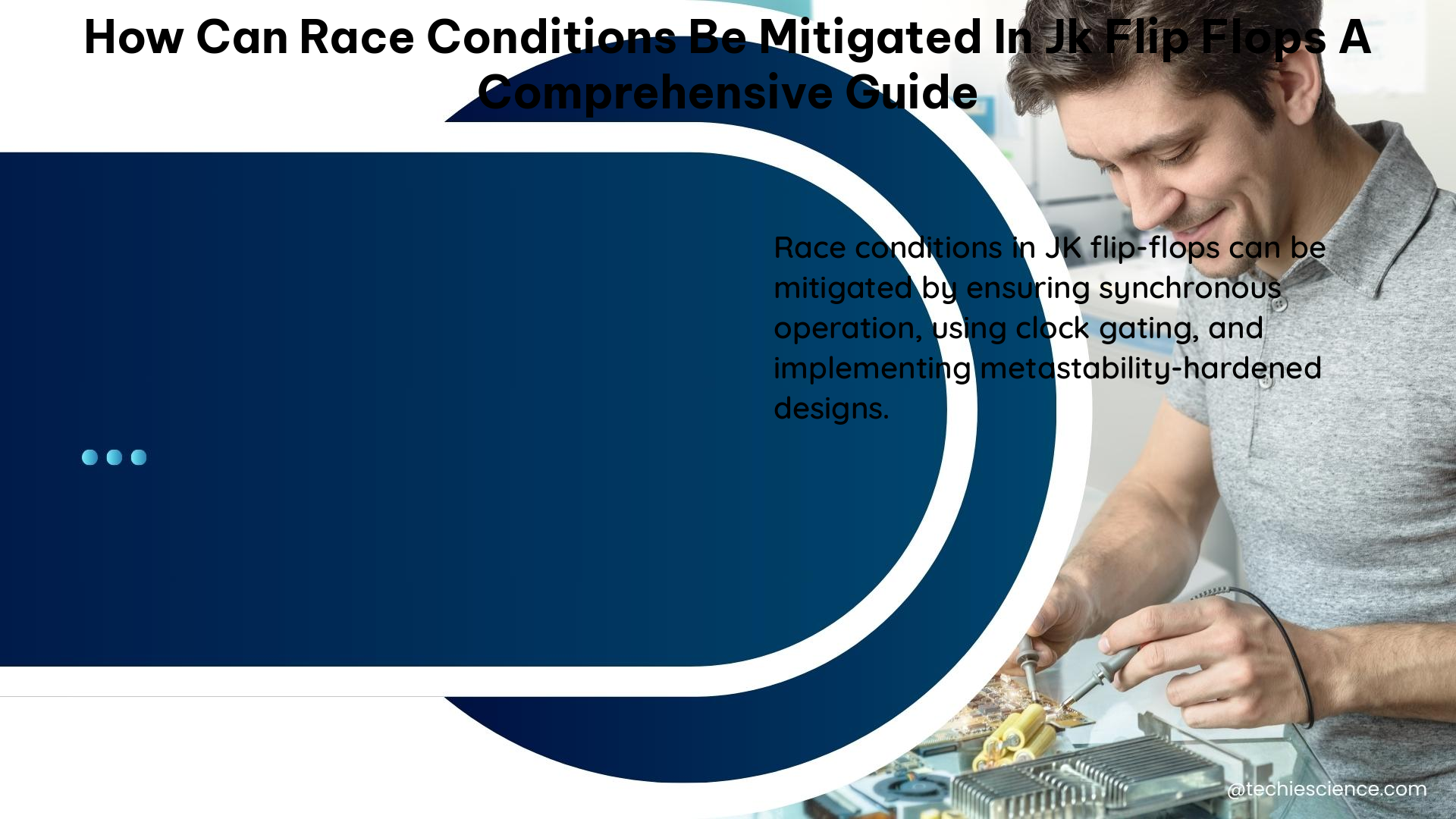Race conditions in JK flip-flops can lead to unstable or unpredictable outputs, which can be a significant challenge in digital circuit design. This comprehensive guide will explore various techniques to mitigate race conditions in JK flip-flops, providing you with a deep understanding of the underlying principles and practical solutions.
Understanding Race Conditions in JK Flip-Flops
Race conditions in JK flip-flops occur when there is a timing-related phenomenon, typically when the S and R inputs of an SR flip-flop are at logical 1, or when the S and R inputs of an SR flip-flop are at logical 1 and then the input is changed to any other condition. This can result in an unstable or unpredictable output, as the flip-flop may enter an undefined state.
The root cause of race conditions in JK flip-flops is the timing relationship between the input signals and the clock signal. If the input signals change during the propagation delay of the flip-flop, the output may not be able to settle to a stable state before the next clock edge, leading to the race condition.
Mitigating Race Conditions: Increasing Propagation Delay

One method to mitigate race conditions in JK flip-flops is by increasing the propagation delay (delta t) of the flip-flop. The propagation delay should be made greater than the duration of the clock pulse (T) to ensure that the output has enough time to settle before the next clock edge.
To quantify this, the propagation delay (delta t) should be at least 2-3 times the clock period (T). For example, if the clock period is 10ns, the propagation delay should be at least 20-30ns. This ensures that the output has enough time to settle before the next clock edge, reducing the likelihood of a race condition.
However, this solution is not ideal as it decreases the speed of the system, as the increased propagation delay can limit the maximum operating frequency of the circuit.
Mitigating Race Conditions: Using Edge-Triggered Flip-Flops
Another method to mitigate race conditions in JK flip-flops is by using edge-triggered flip-flops instead of level-triggered flip-flops. In an edge-triggered flip-flop, the input is captured only at the rising or falling edge of the clock, reducing the chances of the input changing during the propagation delay.
If the clock is High for a time interval less than the propagation delay of the flip-flop, the racing around condition can be eliminated. This is because the input is only sampled at the clock edge, and the output has enough time to settle before the next clock edge.
The use of edge-triggered flip-flops can significantly reduce the race condition window, as the input is only captured at the clock edge, rather than being continuously monitored like in a level-triggered flip-flop.
Mitigating Race Conditions: Using Master-Slave JK Flip-Flops
The third method to mitigate race conditions in JK flip-flops is by using master-slave JK flip-flops. In a master-slave JK flip-flop, the input is captured during one clock edge (the master stage), and the output is produced during the next clock edge (the slave stage).
This ensures that there is no overlap between the input and output stages, eliminating the possibility of a race condition. The master-slave configuration effectively divides the propagation delay into two separate stages, with the input being captured in the master stage and the output being produced in the slave stage.
By using master-slave JK flip-flops, the racing around condition can be eliminated, as the input is captured during one clock edge and the output is produced during the next clock edge, ensuring that there is no overlap between the two stages.
Quantifying the Effectiveness of Mitigation Techniques
To quantify the effectiveness of the mitigation techniques, we can compare the race condition window for different approaches:
- Increasing Propagation Delay:
- Race condition window = Clock period (T) – Propagation delay (delta t)
-
Example: If T = 10ns and delta t = 20ns, the race condition window = 10ns – 20ns = 0ns (no race condition)
-
Using Edge-Triggered Flip-Flops:
- Race condition window = Time interval when clock is High (less than propagation delay)
-
Example: If clock is High for 5ns and propagation delay is 10ns, the race condition window = 0ns (no race condition)
-
Using Master-Slave JK Flip-Flops:
- Race condition window = 0ns (no race condition)
- The input is captured in the master stage, and the output is produced in the slave stage, ensuring no overlap between the two stages.
By quantifying the race condition window for each mitigation technique, you can better understand the effectiveness of each approach and choose the most suitable solution for your specific circuit design requirements.
Conclusion
In this comprehensive guide, we have explored various techniques to mitigate race conditions in JK flip-flops, including increasing the propagation delay, using edge-triggered flip-flops, and employing master-slave JK flip-flops. Each method has its own advantages and trade-offs, and the choice of the most appropriate technique will depend on the specific design requirements and constraints of your digital circuit.
By understanding the underlying principles and applying the quantifiable data points discussed in this guide, you can effectively mitigate race conditions in JK flip-flops and ensure the stability and reliability of your digital systems.
References
- Race Conditions in Flip-Flops
- What is Race Condition in Flip-Flops?
- Race Conditions in Sequential Design
- Master-Slave JK Flip-Flop
- Race Conditions in JK Flip-Flops

The lambdageeks.com Core SME Team is a group of experienced subject matter experts from diverse scientific and technical fields including Physics, Chemistry, Technology,Electronics & Electrical Engineering, Automotive, Mechanical Engineering. Our team collaborates to create high-quality, well-researched articles on a wide range of science and technology topics for the lambdageeks.com website.
All Our Senior SME are having more than 7 Years of experience in the respective fields . They are either Working Industry Professionals or assocaited With different Universities. Refer Our Authors Page to get to know About our Core SMEs.